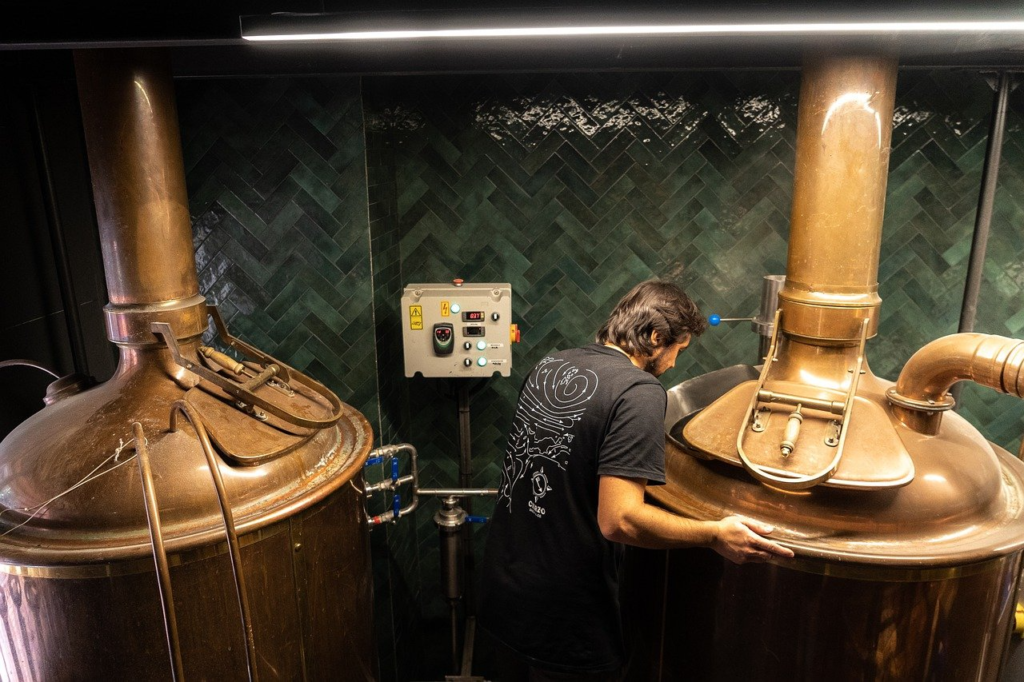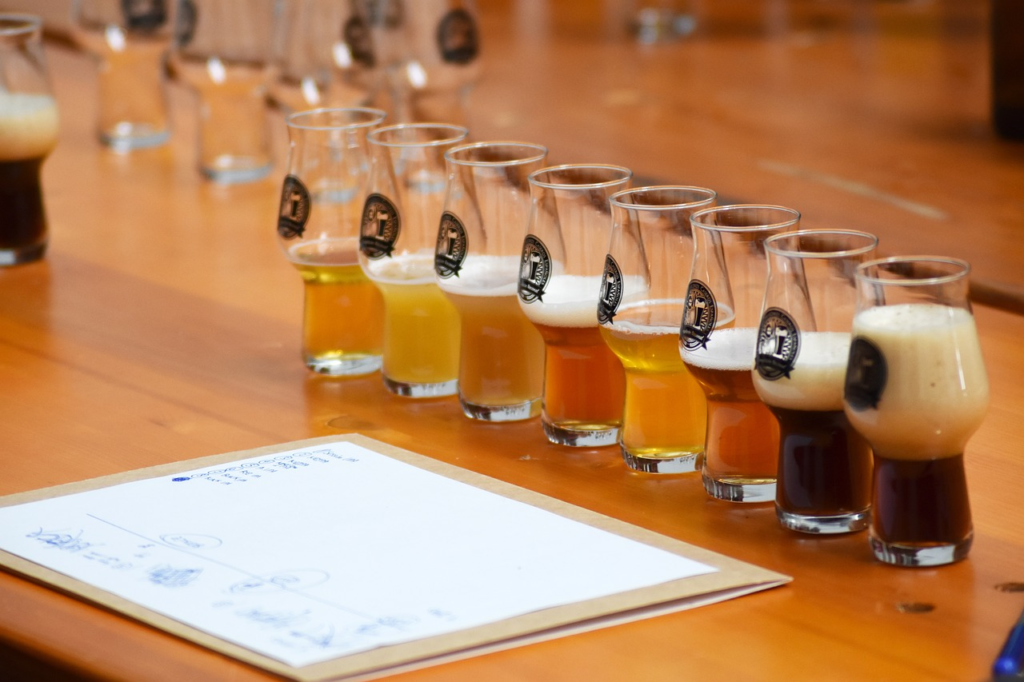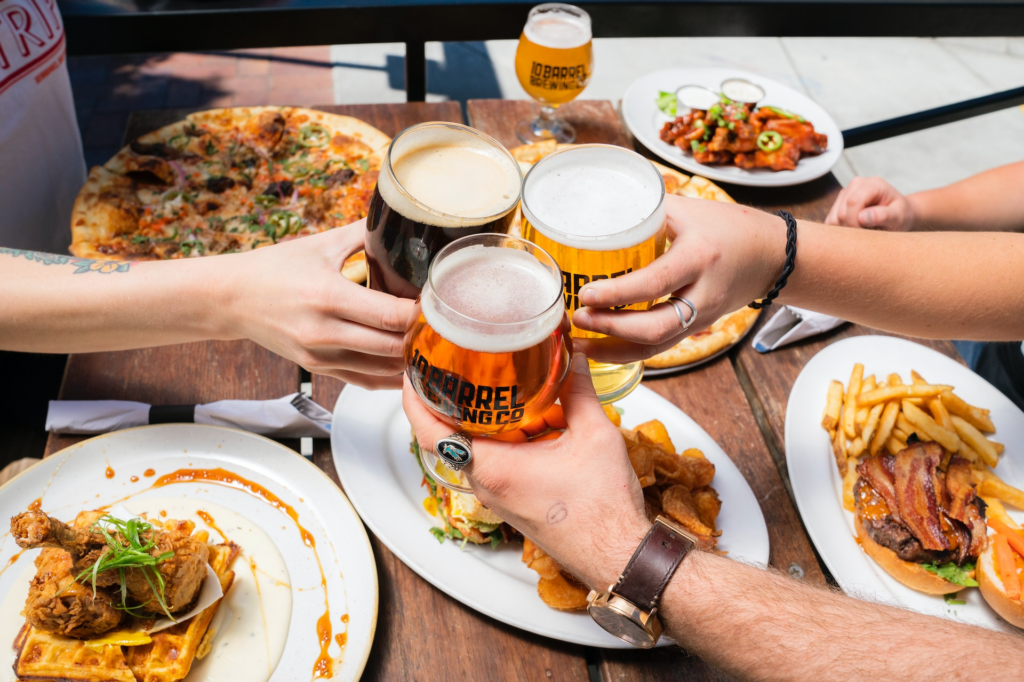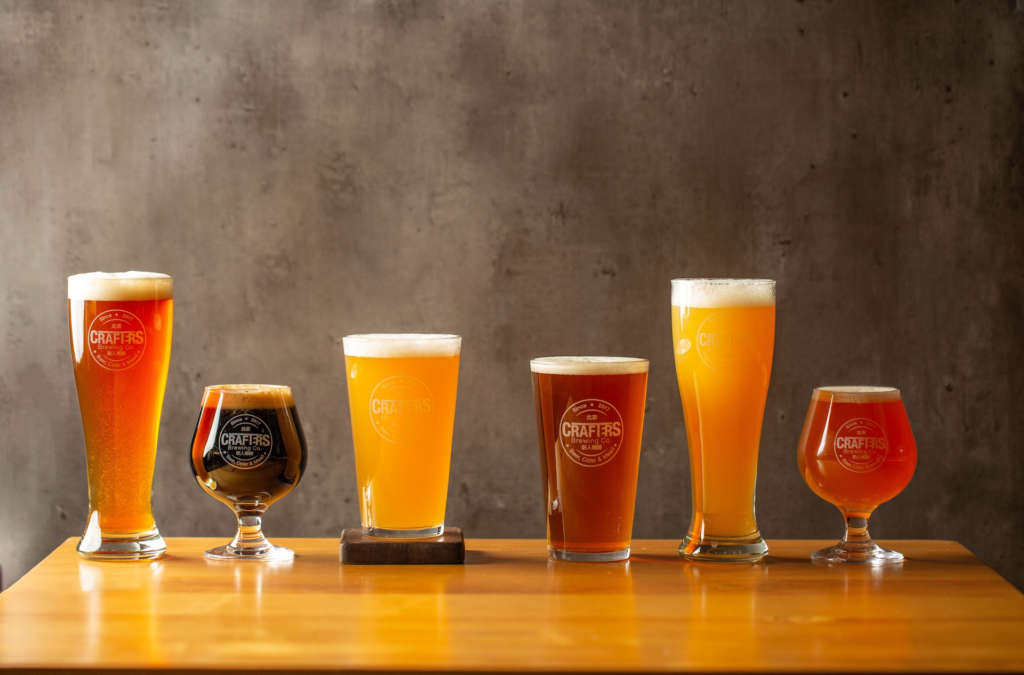
The Rise of Craft Beer
Craft beer has been on the rise for the past few decades, taking over taps and shelves in bars and stores around the world. But where did it all begin? The history of craft beer dates back to the 1970s, when a wave of independent brewers started popping up in the United States.
These brewers were tired of the mass-produced, flavorless beers that dominated the market at the time, and they decided to take matters into their own hands. They experimented with different ingredients, brewing techniques, and styles to create complex, flavorful beers that stood out from their commercial counterparts.
As time went on, craft beer grew in popularity and spread to other parts of the world. Today, there are thousands of small-scale breweries producing unique and innovative beers that cater to every taste preference.
The Growing Popularity of Craft Beer
Craft beer’s popularity has only continued to grow over time. According to a recent report by IBISWorld, craft beer production in the United States alone generates about $29 billion annually.
Consumers are increasingly interested in trying new and unique flavors rather than sticking with mainstream options. One reason for this shift is consumers’ growing interest in supporting local businesses and sustainable practices.
Many craft breweries source their ingredients locally or even grow them on-site, reducing their carbon footprint while supporting local farmers. Another reason is simply taste – craft beer offers a wider range of flavors than traditional beers thanks to its use of specialty malts and hops as well as creative adjuncts such as fruits or spices.
The Importance of Brewing a Perfect Pint
When it comes to craft beer enjoyment, brewing a perfect pint is essential. Unlike mass-produced beers which can often be enjoyed without much thought or attention given to how they were made, craft beer is meant to be savored.
Small changes in the brewing process can have a big impact on the final product, so it’s important to get everything just right. Brewing a perfect pint means achieving a balance of flavors and aromas that come together harmoniously.
It’s about selecting high-quality ingredients and utilizing proper brewing techniques to create a beer that highlights those ingredients. When done correctly, each sip should be an experience – one that you’ll want to savor and remember.
The Ingredients

Water quality and its impact on taste
Water makes up about 90% of any beer, so it’s no surprise that the quality of the water used in brewing has a significant impact on the taste of the final product. Different regions have different mineral content in their water, which can affect the flavor and character of beer brewed with it. For instance, soft water is ideal for brewing lagers, while harder water is more suited for ales.
Some brewers take it a step further and adjust their water by adding specific minerals to create a certain flavor profile. This is particularly popular among German brewers who use this method to replicate traditional regional styles with precision.
But why does water matter so much? Simply put, it affects everything from pH levels to yeast activity during fermentation, all crucial factors in creating great beer.
Types of malt and their flavors
Malt is one of the key ingredients in beer and provides most of its color, flavor, and body. It’s made by germinating barley (or other grains) until they begin to sprout before drying them out in a kiln. The length and temperature of this process will affect the final flavor profile.
Lighter malts produce beers with milder flavors like Pilsners or blondes while darker ones like Chocolate malt or Black Patent give stouts their roasted flavors and dark color. Some brewers experiment with different types of malt or add specialty grains like wheat or rye for different textures or tastes.
Hops varieties and their bitterness levels
Hops provide beer with its distinctive bitterness as well as floral, fruity, or spicy aromas depending on what variety is used. There are hundreds of hop varieties available around the world but some popular ones include Citra (tropical fruit notes), Cascade (floral grapefruit), Saaz (spicy earthiness), and many more.
Hops are added at different stages of the brewing process, with earlier additions imparting bitterness while later ones give more aroma and flavor. The amount of hops used also affects the bitterness levels, with some beers being extremely hoppy (like an IPA) while others have very little or none at all.
Hops are also used as a preservative and to balance out the sweetness from the malted barley. And just like water and malt, hops can be experimented with to create unique flavors or replicate traditional styles.
The Brewing Process

Step-by-Step Breakdown of the Brewing Process
Brewing beer is a complex process that requires precision and attention to detail. The process starts with milling the grains, which breaks them down into smaller particles and exposes their starchy insides. These grains are then mixed with hot water in a process called mashing, which converts the starch into sugar.
This mixture is then boiled while hops are added at specific intervals for flavor and bitterness. After boiling, the liquid is cooled and yeast is added to start fermentation.
Importance of Temperature Control
Temperature control is crucial during brewing because it affects the flavor, aroma, and alcohol content of the beer. Mashing requires precise temperature control to convert starches into sugar effectively. If the temperature is too high or low during fermentation, it can result in off-flavors or slow down the process.
Allowing fermentation temperatures to rise too high can cause unwanted compounds like fusel alcohols, esters, and phenols. The wort also needs to be cooled quickly after boiling before yeast can be added or else it can become infected by bacteria or wild yeasts that will spoil the beer’s flavor profile.
Fermentation and Conditioning
Fermentation occurs after yeast has been added to the wort at specific temperatures for an allotted time period depending on a variety of factors such as yeast strain type, style being brewed and desired level of carbonation. During conditioning (or aging), many brewers recommend moving the beer off its sediment (yeast) onto a secondary fermenter or conditioning vessel where it will age for several weeks before bottling or kegging at lower temperatures than fermentation. Overall, each step of brewing plays an essential role in producing exceptional craft beer that offers unique sensory experiences
Styles of Craft Beer
Craft beer comes in a wide variety of styles, each with their own unique flavor profile. Whether you prefer a hoppy IPA or a smooth stout, there is something out there for everyone. In this section, we’ll take a closer look at some of the most popular styles of craft beer and what makes each one unique.
IPA (India Pale Ale)
The IPA is undoubtedly one of the most popular styles of craft beer. This style originated in England in the 19th century and was designed to withstand the long sea voyage to India without spoiling.
Today, IPAs are known for their bold hop flavors and high ABV (alcohol by volume). There are several sub-styles within the IPA category, including West Coast IPA, New England IPA (NEIPA), and Double/Imperial IPA.
West Coast IPAs tend to be more bitter and piney while NEIPAs are known for their juicy, fruity flavors. Double IPAs have an even higher ABV than regular IPAs and often have more intense hop flavors.
Stout
Stouts are another popular style of craft beer that has been around since the 18th century in Ireland. These beers are dark in color with a creamy head and have a rich, roasted flavor profile with notes of coffee or chocolate. Within the stout category, there are several sub-styles as well, including Irish dry stout (think Guinness), oatmeal stout (made with oats for added creaminess), milk stout (made with lactose for added sweetness), and imperial stout (higher ABV than traditional stouts).
Lager
While lagers may not be as trendy as IPAs or stouts at the moment, they are still one of the most widely consumed types of beer around the world. Lagers undergo a cool fermentation process, which gives them a crisp, refreshing taste.
They are typically light in color and have a lower ABV than other styles of beer. Some popular sub-styles of lager include pilsner (crisp and refreshing with a slightly bitter finish), Vienna Lager (a little darker in color with a slightly sweet flavor profile), and Munich Dunkel (dark brown in color with notes of caramel or toffee).
No matter what style of craft beer you prefer, the key is to keep an open mind and try as many different styles as possible. Who knows – you may just discover your new favorite beer!
Tasting Craft Beer

Craft beer is known for its complex flavors, aromas, and characteristics that make it unique. Tasting craft beer is more than just taking a sip and moving on; it’s about savoring the experience and appreciating the brewer’s artistry. To fully enjoy a craft beer, you need to know how to taste it properly.
Proper Glassware for Each Style
The choice of glassware can greatly influence the taste and presentation of a craft beer. Different styles of beers require different glassware shapes to enhance their aroma, flavor profile, carbonation level, and appearance. For example, a pint glass with a wide mouth is ideal for IPAs as it allows the hop aromas to escape while tulip-shaped glasses are suited for Belgian-style beers such as saisons or tripels as they capture the fruity esters nicely.
Choosing the right glassware can be overwhelming with so many options available in today’s market but investing in some basic glasses is worth your while. A good place to start is with a tulip-shaped glass that works well for most styles or an IPA glass which has been created specifically for hop-driven beers.
How to Properly Pour a Beer
Pouring craft beer into a glass isn’t just about aesthetics; it can also affect its flavor profile. A proper pour involves tilting the glass at an angle while gradually adding the beer by pouring down along one side of the tilted surface. The goal is to create about two fingers’ worth of head which helps release aroma compounds trapped in foam bubbles whilst aerating your beer which alters perception on our palate.
It’s important not to rush this process because pouring too fast will create too much head whilst not tilting your glass will cause too little head retention resulting in loss of aromatics and flavours . You should also avoid using dirty glasses or using cold, wet glasses that can produce too much foam and affect the carbonation levels of your beer.
Tips for Tasting Notes
Tasting craft beer is not just about the flavor, but also the aroma, mouthfeel, and aftertaste. You can train your palate by tasting a variety of beers over time to detect subtle differences and nuances in flavors. When tasting craft beer make sure to pay attention to its aroma before taking a sip.
Then take a small sip and let it sit on your tongue for a moment before swallowing it to fully experience the different flavors and texture. As you swallow, breathe out through your nose as this will help activate olfactory receptors in your nasal cavity which will impact how we perceive taste.
Write down what you experienced while tasting each beer along with any notes that come to mind on things like how bitter or sweet it was or even what food would pair well with it. This type of note taking allows you to compare beers later and form opinions on what works best for you!
Pairing Craft Beer with Food

General Pairing Guidelines
Craft beer is a versatile drink that pairs well with an enormous variety of foods. As with wine, certain styles of beer pair particularly well with certain types of cuisine.
The general rule of thumb for pairing craft beer is to match the intensity and weight of the food to the intensity and weight of the beer. For example, a light lager would pair well with light dishes such as salads or seafood, while a heavier stout or porter would be better suited to heartier dishes like grilled meats or stews.
Another important factor in pairing craft beer with food is to consider how the flavors will interact. Light beers tend to have less bitterness and more subtle flavors, while darker beers can be more complex and rich.
Spicy foods can pair very well with hoppy IPAs, which help to cut through the heat and refresh the palate. Similarly, sour beers can complement tangy or acidic dishes like ceviche or tomato-based sauces.
Specific Food Pairings for Different Styles
When it comes to specific food pairings for different styles of craft beer, there are countless possibilities depending on individual tastes and regional preferences. Here are just a few examples:
– IPA: This popular style has a strong hop flavor that pairs well with spicy foods like buffalo wings or Thai curries. It also goes surprisingly well with fatty foods like burgers or fried chicken.
– Stout: Dark and rich stouts are perfect for hearty comfort foods like chili con carne or shepherd’s pie. They also make an excellent dessert pairing for chocolate-based sweets.
– Pilsner: Crisp and refreshing pilsners work great with lighter fare like salads, sandwiches, or sushi rolls. – Belgian Dubbel: With its fruity aroma and sweet caramel flavor profile, Belgian dubbel pairs wonderfully with meaty dishes like roast beef or pork chops.
– Wheat Beer: Light and effervescent wheat beers have a subtle citrusy flavor that pairs well with fresh seafood like oysters or shrimp cocktail. When it comes to exploring the world of craft beer and food pairings, the possibilities are endless.
Don’t be afraid to experiment with different styles and cuisines until you find your perfect match. Cheers!
Uncommon Facts about Craft Beer

Unique Ingredients Used in Some Craft Beers
Craft beer brewing is a creative and experimental process, and some brewers take that to the extreme by incorporating unusual ingredients into their brews. Take, for example, The Bruery’s “White Chocolate” beer, which is brewed with cocoa nibs and vanilla beans to give it a creamy white chocolate flavor. Or how about Rogue’s “Beard Beer”, which is brewed using yeast strains collected from the beard of one of their brewers?
Another unique ingredient used in craft beers is oysters. That’s right, oysters!
Oyster stouts were first brewed in the 18th century in England and were thought to be highly nutritious due to their high zinc content. Today, breweries such as Maine Beer Company and Dogfish Head Brewery use oysters in some of their stouts for a briny taste that pairs well with the roasted malt flavors.
Fun Historical Facts About Beer
Beer has been around for thousands of years and has played an important role in many cultures throughout history. Did you know that ancient Egyptian hieroglyphics indicate that beer was being brewed as far back as 5,000 BC? Or that women were traditionally the primary brewers in Sumerian culture? In fact, the goddess Ninkasi was considered the patron saint of brewing!
During prohibition in the United States (1920-1933), it was still legal to buy and sell alcohol if it was labeled as medicine. This led to a surge in “medicinal” beers such as “Dr.
Heileman’s Old Style Lager”, which claimed to be a cure for various ailments. Did you know that beer helped build America?
Many early American colonies had laws requiring every household to brew beer due to its importance as a safe source of hydration. The first brewery in America was founded in 1632 in Manhattan by a Dutch immigrant named Adriaen Block, and beer was even used as currency during the colonial era.
Key Takeaways on Brewing the Perfect Pint
Brewing the perfect pint of craft beer is an art form that requires patience, precision, and passion. We’ve learned that high-quality ingredients such as water, malt, and hops are essential components in creating a flavorful brew.
The brewing process itself is equally important, from temperature control during mashing to yeast pitching during fermentation. Knowing about different styles of craft beer, their characteristics, and how to properly taste and pair them with food can enhance your overall enjoyment of this beloved drink.
To recap the key takeaways on brewing the perfect pint: – High-quality ingredients are essential for a great-tasting beer
– The brewing process requires careful attention to detail – Understanding different styles of craft beer can enhance your enjoyment
Encouragement to Explore the World of Craft Beer
Craft beer has become increasingly popular in recent years, with more and more breweries popping up around the world. Exploring this diverse world of flavors can be an exciting adventure for any beer lover.
So why not step out of your comfort zone and try new styles you’ve never had before? Attend local brewery events or festivals to sample various types of beers from different brewers.
Share your experiences with friends or join online communities dedicated to discussing craft beers. By exploring the world of craft beer and appreciating its unique characteristics, you may even gain a newfound appreciation for this beverage that has been enjoyed for centuries.
Brewing the perfect pint is no easy feat but understanding its nuances can lead you to enjoy it even more. So don’t be afraid to experiment with different styles and flavors; there’s always something new waiting to be discovered in the ever-evolving world of craft beer.